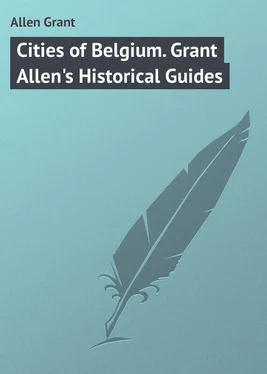Grant Allen - Cities of Belgium. Grant Allen's Historical Guides
Здесь есть возможность читать онлайн «Grant Allen - Cities of Belgium. Grant Allen's Historical Guides» — ознакомительный отрывок электронной книги совершенно бесплатно, а после прочтения отрывка купить полную версию. В некоторых случаях можно слушать аудио, скачать через торрент в формате fb2 и присутствует краткое содержание. ISBN: , Издательство: Иностранный паблик, Жанр: foreign_language, foreign_prose, на английском языке. Описание произведения, (предисловие) а так же отзывы посетителей доступны на портале библиотеки ЛибКат.
- Название:Cities of Belgium. Grant Allen's Historical Guides
- Автор:
- Издательство:Иностранный паблик
- Жанр:
- Год:неизвестен
- ISBN:http://www.gutenberg.org/ebooks/49690
- Рейтинг книги:3 / 5. Голосов: 1
-
Избранное:Добавить в избранное
- Отзывы:
-
Ваша оценка:
- 60
- 1
- 2
- 3
- 4
- 5
Cities of Belgium. Grant Allen's Historical Guides: краткое содержание, описание и аннотация
Предлагаем к чтению аннотацию, описание, краткое содержание или предисловие (зависит от того, что написал сам автор книги «Cities of Belgium. Grant Allen's Historical Guides»). Если вы не нашли необходимую информацию о книге — напишите в комментариях, мы постараемся отыскать её.
Cities of Belgium. Grant Allen's Historical Guides — читать онлайн ознакомительный отрывок
Ниже представлен текст книги, разбитый по страницам. Система сохранения места последней прочитанной страницы, позволяет с удобством читать онлайн бесплатно книгу «Cities of Belgium. Grant Allen's Historical Guides», без необходимости каждый раз заново искать на чём Вы остановились. Поставьте закладку, и сможете в любой момент перейти на страницу, на которой закончили чтение.
Интервал:
Закладка:
By the centre window, a *triptych, doubtfully attributed to Memling, represents, in the centre, the Deposition from the Cross, with the Holy Blood conspicuous, as might be expected in a Bruges work. In the foreground are St. John, the Madonna, and St. Mary Magdalene; in the background, the preparations for the Deposition in the Tomb. On the wings: left , Brother Adrian Reins, the donor, with his patron saint, Adrian, bearing his symbol, the anvil, on which his limbs were struck off, and with his lion at his feet; right , St. Barbara with her tower, perhaps as patroness of armourers. On the exterior wings, left , St. Wilgefortis with her tau-shaped cross; right , St. Mary of Egypt, with the three loaves which sustained her in the desert.
On the same stand is the beautiful *diptychby Memling, representing Martin van Nieuwenhovenadoring the Madonna. The left panel represents Our Lady and the Child, with an apple, poised on a beautifully painted cushion. A convex mirror in the background reflects the backs of the figures (as in the Van Eyck of the National Gallery). Through the open window is seen a charming distant prospect. The right panel has the fine portrait of the donor, in a velvet dress painted with extreme realism. Note the admirable prayer-book and joined hands. At his back, a stained glass window shows his patron, St. Martin, dividing his cloak for the beggar. Below, a lovely glimpse of landscape. This is probably Memling’s most successful portrait. Dated 1487: brought here from the Hospice of St. Julian, of which Martin was Master.
In all Flemish art, observe now the wooden face of the Madonna– ultimately derived, I believe, from imitation of painted wooden figures, and then hardened into a type. As a rule, the Madonna is the least interesting part of all Flemish painting; and after her, the women, especially the young ones. The men’s faces are best, and better when old: character, not beauty, is what the painter cares for. This is most noticeable in Van Eyck, but is true in part even of Memling.
At the end of the room is the magnificent *triptychpainted by Memling for the High Altarof the Church of this Hospital. This is the largest of his works, and it is dedicated to the honour of the two saints (John the Evangelist and John the Baptist) who are patrons of the Hospital. The central panelrepresents Our Lady, seated in an exquisite cloister, on a throne backed with cloth of gold. To the right and left are two exquisite angels, one of whom plays a regal, while the other, in a delicious pale blue robe, holds a book for Our Lady. Two smaller angels, poised in air, support her crown. To the left, St. Catherine of Alexandria kneels as princess, with the broken wheel and the sword of her martyrdom at her feet. The Child Christ places a ring on her finger; whence the whole composition is often absurdly called “The Marriage of St. Catherine.” It should be styled “The Altar-piece of the St. Johns.” To the right is St. Barbara, calmly reading, with her tower behind her. When these two saints are thus combined, they represent the meditative and the active life (as St. Barbara was the patroness of arms:) or, more definitely, the clergy and the knighthood. Hence their appropriateness to an institution, half monastic, half secular. In the background stand the two patron saints; St. John Baptist with the lamb (Memling’s personal patron), to the left, and St. John the Evangelist with the cup and serpent, to the right. (For these symbols, see Mrs. Jameson.) Behind the Baptist are scenes from his life and preaching. He is led to prison, and his body is burned by order of Julian the Apostate. Behind the Evangelist, he is seen in the cauldron of boiling oil. The small figure in black to the right is the chief donor, Brother Jan Floreins, who is seen further back in his secular capacity as public gauger of wine, near a great crane, which affords a fine picture of mercantile life in old Bruges. The left wing represents the life of St. John the Baptist. In the distance is seen the Baptism of Christ. In a room to the left, the daughter of Herodias dances before Herod. The foreground is occupied by the episode of the Decollation, treated in a courtly manner, very redolent of the Burgundian splendour. Figures and attitudes are charming: only, the martyrdom sinks into insignificance beside the princess’s collar. Other minor episodes may be discovered by inspection. (The episodes on either wing overflow into the main pictures.) The right wing shows St. John the Evangelist in Patmos, writing the Apocalypse, various scenes from which are realistically and too solidly represented above him, without poetical insight. Memling here attempts to transcend his powers. He has no sublimity. On the exterior of the wings are seen the four other members of the society who were donors of the altar-piece; Anthony Zeghers, master of the Hospital, with his patron, St. Anthony, known by his pig and tau-shaped crutch and bell: Jacob de Cueninc, treasurer, accompanied by his patron, St. James the Greater, with his pilgrim’s staff and scallop-shell: Agnes Casembrood, mistress of the Hospital, with her patron, St. Agnes, known by her lamb: and Claire van Hulsen, a sister, with her patron, St. Clara. Dated, 1479.
By the entrance door is a Portrait of Marie Moreel, represented as a Sibyl. She was a daughter of Willem Moreel or Morelli, a patron of Memling, whom we shall meet again at the Museum. This is a fine portrait of a solid, plain body, a good deal spoiled by attempted cleaning. It comes from the Hospice of St. Julian.
As you go out, cast a glance at the fine old brick buildings, and note the cleanliness of all the arrangements.
Return more than once: do not be satisfied with a single visit.
The other pictures and objects formerly exhibited in this Hospital have been transferred to the Potterie and another building. They need only be visited by those whose time is ample.
After leaving the Hospital, I do not advise an immediate visit to the Academy. Let the Memlings first sink into your mind. But the walk may be prolonged by crossing the canal, and taking the second turning to the R., which leads (over a pretty bridge of three arches) to the Béguinage, a lay-nunnery for ladies who take no vows, but who live in monastic fashion under the charge of a Superior. Above the gateway is a figure of St. Elizabeth of Hungary, (to whom the church within is dedicated) giving alms to a beggar. She wears her crown, and carries in her hand the crown and book which are her symbol. Remember these, – they will recur later. Pass under the gateway and into the grass-grown precincts for an external glimpse of the quiet old-world close, with its calm white-washed houses. The church, dedicated to St. Elizabeth, is uninteresting. This walk may be further prolonged by the pretty bank of the Lac d’amour or Minnewater as far as the external canal, returning by the ramparts and the picturesque Porte de Gand.
D. THE TOWN IN GENERAL
[The town of Bruges itselfis more interesting, after all, than almost any one thing in it. Vary your day by giving up the morning to definite sight-seeing, and devoting the afternoon to strollsthrough the town and neighbourhood, in search of picturesqueness. I subjoin a few stray hints for such casual rambles.]
(1) Set out from the Grand’ Place, and turn down the Rue Breydel to the Place du Bourg. Cross the Place by the statue of Jan van Eyck; traverse the Rue Philippe Stock; turn up the Rue des Armuriers a little to the R., and continue on to the Place St. Jean, with a few interesting houses. Note here and elsewhere, at every turn, the little statues of the Virgin and Child in niches, and the old signs on the fronts or gables. The interesting Gothic turretwhich faces you as you go belongs to the old 14th Century building called De Poorters Loodge, or the Assembly Hall of the Noble Citizens Within the Gate, as opposed to those of the Franc de Bruges. Continue on in the same direction to the Place Jan van Eyck, where you open up one of the most charming views in Bruges over the canal and quays. The Place is “adorned” by a modern statue of Jan van Eyck. The dilapidated building to your L. is that of the Académie des Beaux-Artswhich occupies the site of the Citizens’ Assembly Hall: the ancient edifice was wholly rebuilt and spoilt in 1755, with the exception of the picturesque tower, best viewed from the base of the statue. Opposite you, as you emerge into the Place, is the charming Tonlieuor Custom House, whose decorated façade and portal (restored) bear the date 1477, with the arms of Pieter van Luxemburg, and the collar of the Golden Fleece. The dainty little neighbouring house to the L., now practically united with it, has a coquettish façade : the saints in the niches are St. George, St. John Baptist, St. Thomas à Becket, (or Augustine?) and St. John the Evangelist.
Читать дальшеИнтервал:
Закладка:
Похожие книги на «Cities of Belgium. Grant Allen's Historical Guides»
Представляем Вашему вниманию похожие книги на «Cities of Belgium. Grant Allen's Historical Guides» списком для выбора. Мы отобрали схожую по названию и смыслу литературу в надежде предоставить читателям больше вариантов отыскать новые, интересные, ещё непрочитанные произведения.
Обсуждение, отзывы о книге «Cities of Belgium. Grant Allen's Historical Guides» и просто собственные мнения читателей. Оставьте ваши комментарии, напишите, что Вы думаете о произведении, его смысле или главных героях. Укажите что конкретно понравилось, а что нет, и почему Вы так считаете.












